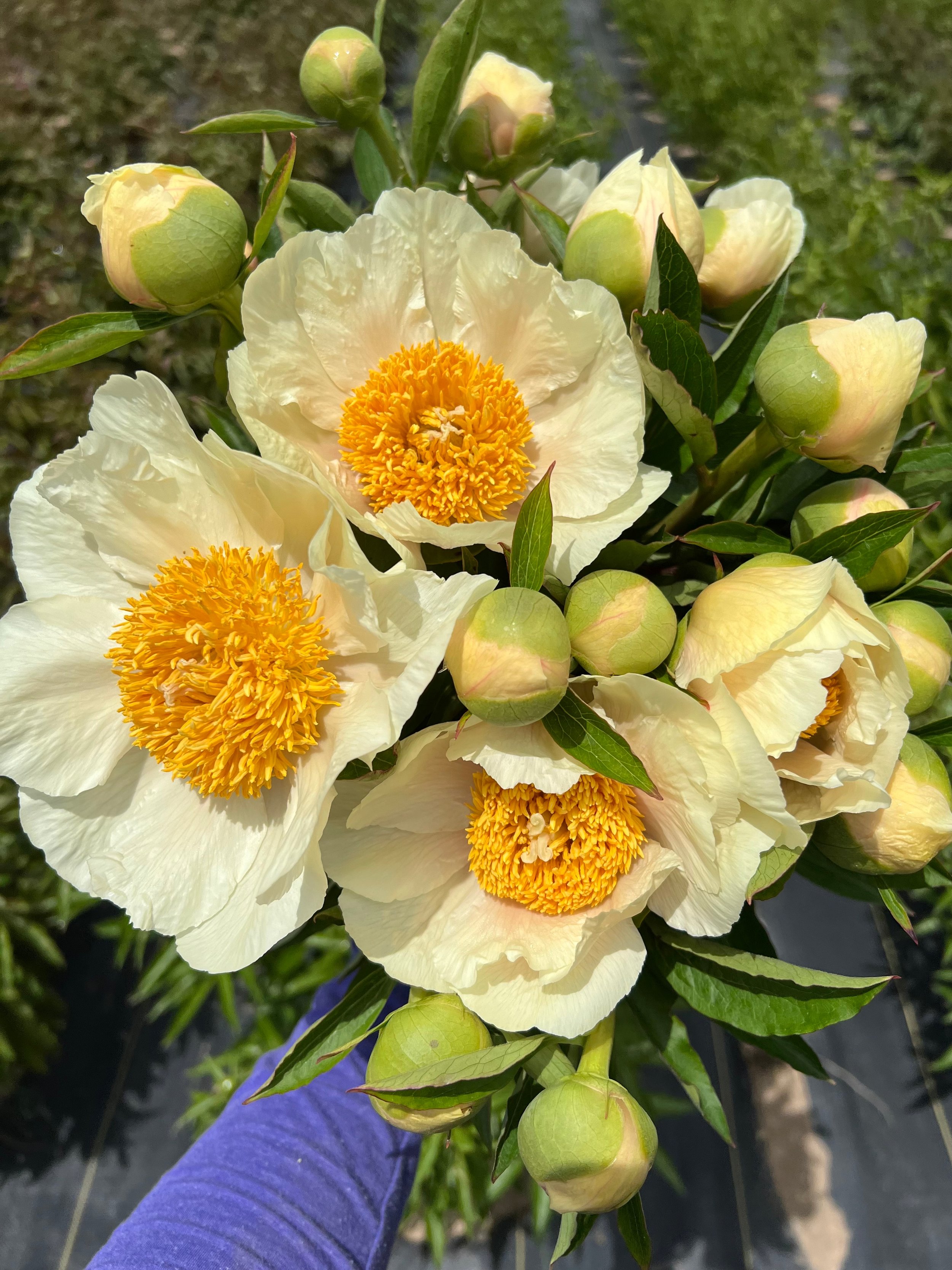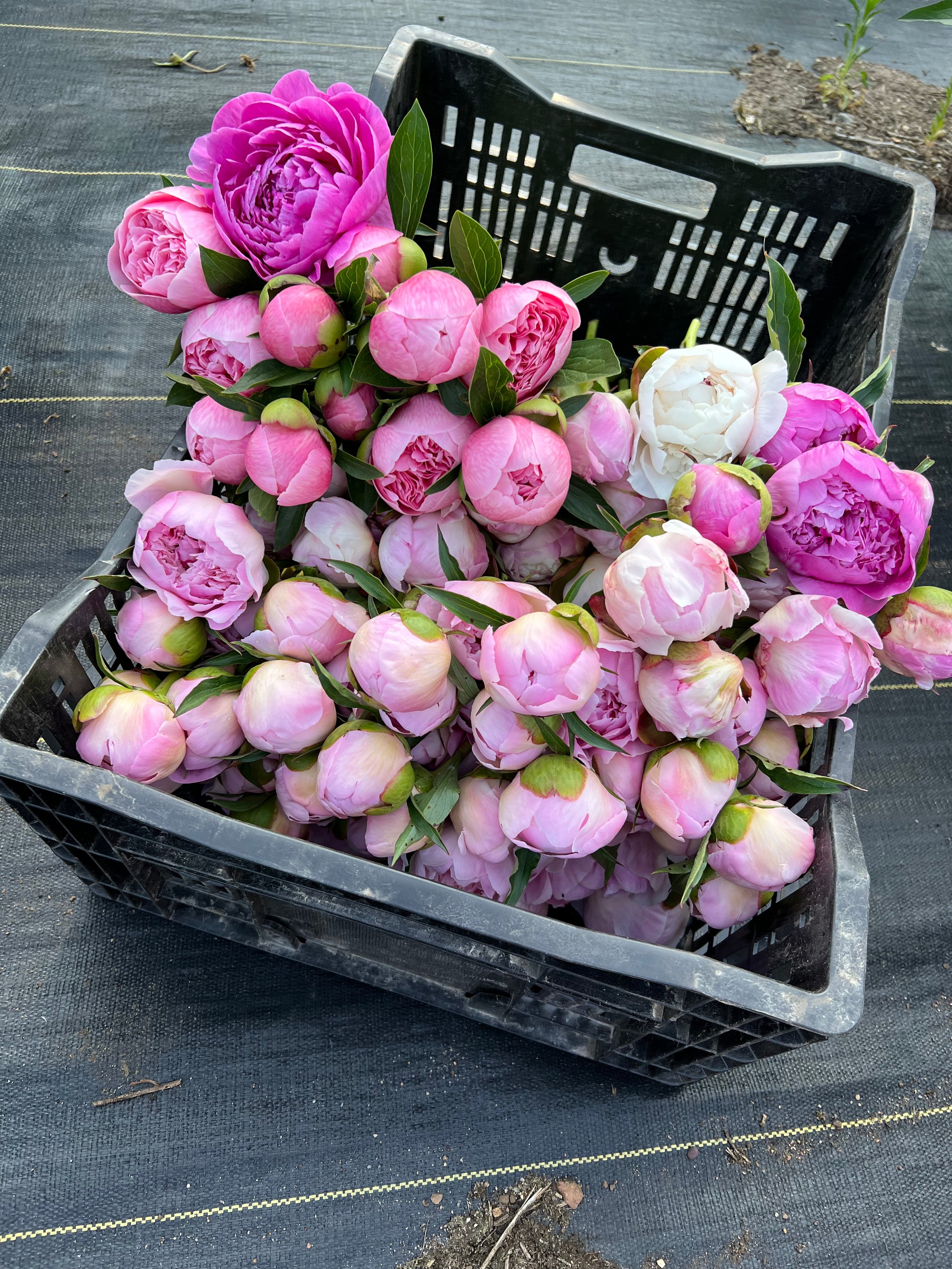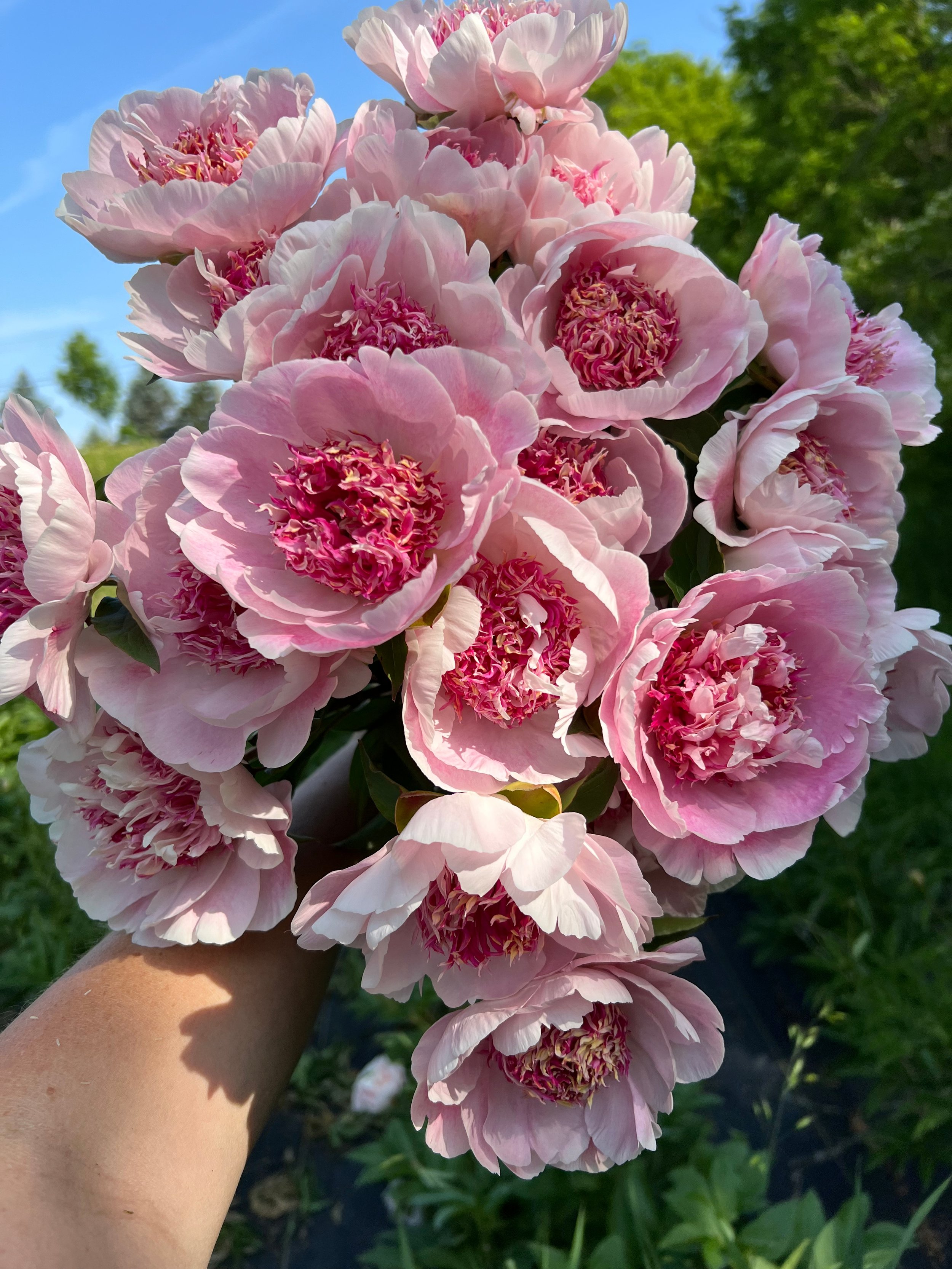Why Grow Peonies on Your Flower Farm
It was mid-May and the last of our tulip crop had just left the farm. I finally had a chance to breathe and check on the peony field. Much to my surprise, Clair de Lune, our first peony to bloom, was starting to pop.
When I saw those soft yellow flowers, it hit me—why am I working so dang hard growing ALL the flowers when peonies bloom beautifully with minimal effort?
I hadn’t done a thing to the peonies all spring, yet here they were, about to bloom beautifully.
Tulip planting, harvesting, and processing is back-breaking. Ranunculus need to be babysat all winter long continuously being covered and uncovered. Annuals require seed starting, transplanting, pinching, bug battling and disease fighting.
And then there are peonies, blooming beautifully with hardly any work. Easy to take care of. Simple to harvest. Lucrative stem prices. Incredible demand. A cut-and-forget-about plant. And they just kept getting better with time. Why not double down on peonies?
And that’s where we are today. Over the past few years, I’ve stopped growing other flowers knowing the end result will be just peonies. Non-peony perennials were the first to go. I didn’t care to weed them all season for two weeks of blooms.
Foliage was next. Then annuals and daffodils. Now I’m down to just five flowers: dahlias, peonies, ranunculus, anemones, and tulips. I know one day in the near future: we’ll be a peony farm.
Instead of Muddy Acres Flower Farm, we will be Muddy Acres Peony Farm. But everything in due time.
Benefits of Growing Peonies
There are so many incredible benefits to growing peonies, it’s essentially a no-brainer. Well, to me anyway! Let’s dig into the benefits of peonies so you can truly see how incredible they are.
Minimal Labor Requirements
Peonies are incredibly low maintenance, requiring very little physical work to thrive. I call them a harvest-and-forget-about-it plant. While that’s not entirely true, it’s pretty dang close. Our peonies are in a separate field at the far back of our property. Once peony season is over, I don’t revisit the field until the fall when it’s time to cut them down unless I get an urge to do some weeding.
I think you and I both know the perks of low-maintenance flowers, but I want to mention a few that might really resonate. When you have a low-maintenance plant, you have more time and energy to devote to life. Living. Hobbies. Your health. Family.
I don’t need to elaborate on this because you know exactly what I’m talking about. So you may be wondering, what labor is actually involved in growing and harvesting peonies.
When it comes down to it, there are really only three steps of labor involved in growing and harvesting peonies:
Initial planting: This first step is about getting the peonies in the ground. Choose a good spot, prepare the soil, and plant the roots. Once this step is done, you don’t have to do it again.
Field maintenance: After planting, you need to take care of the field. This mostly means weeding and occasionally treating or spraying to prevent pests and diseases. Peonies are pretty tough, so they don’t need too much attention. More on this later on.
Harvest: The busiest part is the harvest. It’s all about picking the flowers at the right time, which is when the buds are soft, but not fully open. Then, you cut the flowers, process them, and sell them.
Longevity and Generational Potential
Another perk to growing peonies is their longevity. These flowers can live for more than 100 years, so the upfront work can keep giving you beautiful blooms for generations. Not a season. Not years. Generations.
I did a reel about that on Instagram and it went viral. Crazy viral. The reel simply said that my boys could take over the peony field one day if they wanted. Each year, harvest 15 stems from each of the 4,000 plants and sell them for $4 each. That’s $240k for just one month of work. And this could be a different take on generational wealth.
Granted this is simply a snapshot of the general idea, but what a great way to transfer “wealth” to the next generation.
Ideal Blooming Season for Families
Speaking of my boys, the blooming schedule of peonies aligns perfectly with their school calendar. Our peonies typically bloom from late May through early to mid-June, and by the time my boys are out of school in mid-June, the peony season is just wrapping up. This timing works out perfectly for me. While the blooming period will vary based on your location, or if your children’s school schedule is different. But here in zone 6a, the peony season allows me to wind down and enjoy summer break with my kids.
Seasonal Demand
There’s nothing quite like the demand for fresh flowers in the spring. After everyone has been cooped up inside for the winter season, they’re ready for fresh, colorful flowers. It’s also the season of graduation parties—I’ve sold SO many peonies for grad parties—,weddings, Mother’s Day, and more.
Popularity in Weddings
Peonies are one of the most sought-after wedding flowers and that’s not changing anytime soon. Their lush, romantic blooms make them a favorite among brides and wedding planners.
Shipping Viability
Peonies can also be shipped, which allows these beautiful blooms to reach a wider market. Oftentimes when farming flowers, we’re limited to our local community because we sell a fresh product. But because peonies can be shipped, your market expands much wider than your local community. This is a game-changer, especially for growers in rural or low-income areas.
Storage Capability
Another great thing about peonies is that you can store them in a cooler for a period of time after harvesting. What this really means is that you don’t have to sell them all right away. You can keep them fresh and in good condition for up to two months, giving you the flexibility to sell them later when the demand is higher or for specific events.
This storage ability is really handy, as it allows you to plan better and make the most out of your peony harvest.
Deer Resistance
Actually, I should say pest resistance.
The deer always try to devour my tulips. The Japanese beetles destroy my dahlias and the grasshoppers never stop. Want to know what goes after the peonies? Nothing. And I’m not being dramatic. We have deer, rabbits, voles, and everything else and nothing bothers the peonies!
While the deer still walk through them and leave droppings everywhere, they don’t eat them.
High Market Value
I saved my favorite perk for last. Peonies fetch a premium price in the market, with prices ranging from $3 up to $15 per stem. There’s no better way to show you why this matters than looking at the numbers.
Sell 200 ranunculus at $2: $400 in sales
Sell 200 zinnias at $1.25: $250 in sales.
Sell 200 peonies at $4: $800 in sales.
Mind blowing right? And that, my friend, is why I doubled down on peonies. Peonies are a dream flower.
Things to Keep in Mind
To be fair, let’s look at the cons. And there are really only 4: climate, initial investment, space, and time.
Climate
Unfortunately, not everyone can grow peonies. Peonies can be grown in USDA Hardiness Zones 3 through 8. In these zones, peonies thrive due to the climate conditions that provide a necessary period of winter chilling, which is essential for bud formation.
Zones 3-4: These are colder regions where peonies do exceptionally well, as the plants require a period of winter dormancy.
Zones 5-7: These are considered ideal for peonies, offering a balance of cold for dormancy and warm summers for optimal growth and flowering.
Zone 8: This is on the warmer end of their range. In these areas, it’s important to choose peony varieties that are less demanding in terms of chill hours and to plant them in a location where they can stay cool and well-watered during hot summers.
Zones 9+: Growing peonies can be challenging due to insufficient cold periods, which are crucial for the development of their flower buds. However, with proper care and selecting the right varieties, it can sometimes be possible to grow them in these warmer zones.
Initial Investment
Starting a peony farm involves a significant initial investment, particularly purchasing peony roots and landscape fabric. Wholesale peony roots are generally between $5 and $15 per plant, depending on the variety and quality. This can quickly add up, especially for a larger scale operation. While these costs may seem high initially, they’re part of a long-term investment.
Additionally, while using landscape fabric isn’t mandatory, it’s a wise investment for peony farming to help with keeping the weeds at bay. However, the cost of covering a large area with landscape fabric can be significant.
Here are three mindset shifts to help ease the stress of the initial costs:
The costs are a tax deduction. The roots, landscape fabric, soil amendments—they’re all write offs.
The cost of a Sarah Bernhart root with three to five eyes is cheaper than a latte from Starbucks, a single dahlia tuber, or a packet of zinnia seeds. Perspective is everything.
These are one-time costs. They seem like a lot because they all happen at one time. Let's say you invest $5,000. If you spread that investment out over 25 years, that’s $200 a year. Let’s say you invest $50,000. If you spread that out over 25 years, that’s $2,000 a year which is less than what I used to spend each season just growing annuals!
Space
One of the challenges of growing peonies is the amount of space they require. While you don’t need acres upon acres, you do need some room. Each peony plant requires adequate spacing to ensure proper air circulation and sunlight exposure—both critical for healthy growth and bloom production.
Unlike most annual flowers that require just 6-9” of spacing, peonies need at least 2-3’ between plants. So if you have 10 rows of 25 peonies, you’d need 20-30’ by 50-75’ of growing space. This can be a constraint, especially for those with limited land resources or in urban settings.
Time
Peony farming requires a lot of patience because these plants take time to mature. You typically aren’t able to harvest any flowers until the third year. It’s a long-term commitment, but once the peonies mature, they’ll reward you with plenty of beautiful flowers year after year.
Deciding if Peonies Are Right for Your Flower Farm
Looking back on my journey in flower farming, I can now see a transition that, although unplanned, turned out to be quite beneficial. In the early days, I grew it all.
Around year three, I planted our first 2,500 peony plants. While they were establishing, I had the chance to make a name for myself and Muddy Acres Flower Farm within the community. We became known for our subscriptions and U-Picks. As the peonies started to really get going, I started letting go of some of the flowers so I could focus on a few key crops—especially peonies.
This natural progression allowed me time to market the farm and build a reputation, while also giving the peonies the time they needed to thrive. It was an unplanned strategy but one that has beautifully fallen into place.
If you're thinking about farming peonies for profit, be sure to check out Growing Peonies for Profit. This guide offers an in-depth look at what it takes to build a peony business and helps you determine if it's the right fit for you.






